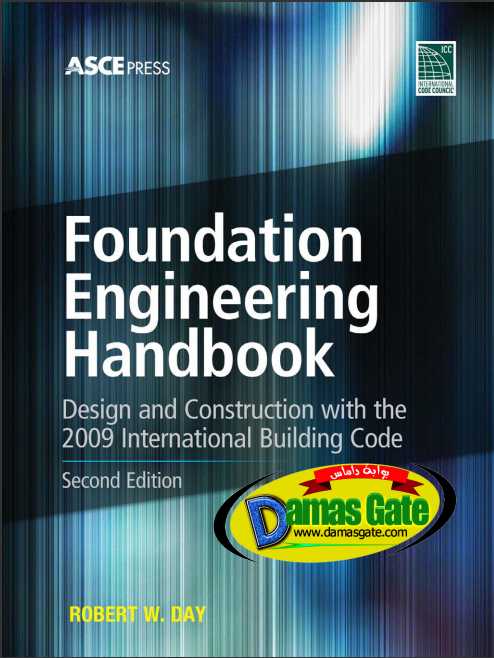Foundation Engineering Handbook - 2nd Edition - Robert W. Day

PREFACE
The goal of the book is to present the practical aspects of geotechnical and foundation engineering.
While the major emphasis of college education is engineering analyses, this often represents only a
portion of the knowledge needed to practice geotechnical engineering. One objective of this book is to
discuss the engineering judgment that needs to be acquired through experience. An example is the
application of sufficient redundancy in the design and construction of the project.
In California, structural engineers typically perform the actual structural design of the foundation
based on the recommendations supplied by the geotechnical engineer. Foundation design, in terms
of determining the type and spacing of steel reinforcement in concrete footings, is not covered in this
textbook. This book deals only with the geotechnical aspects of foundation engineering. In addition,
this book is only applicable for the analyses of clean soil, which does not contain any known or suspected
hazardous materials. Such environmental
issues are outside the scope of this book.
Because of the assumptions and uncertainties associated with geotechnical engineering, it is often
described as an “art,” rather than an exact science. Thus simple analyses are prominent in this book,
with complex and theoretical evaluations kept to an essential minimum. For most projects, a limited
number of borings or test pits are used to investigate the soil and geologic makeup of a site. Hence,
except for cases where the site consists of solid rock, there will usually be uncertainty in the final
analyses. Because of this, when dealing with foundations bearing on soil, it is always best to take a
conservative approach.
Part 1 (Chapters 2 to 4) deals with basic geotechnical field and laboratory studies, such as subsurface
exploration and laboratory testing of soil, rock, or groundwater samples. Part 2 (Chapters 5 to 14)
presents the geotechnical aspects of foundation engineering, including the conditions commonly
encountered by the design engineer, such as settlement, expansive soil, and slope stability.
Part 3 (Chapters 15 to 17) provides a discussion of the performance or engineering evaluation of foundation
construction, and Part 4 (Chapters 18 and 19) consists of concluding chapters dealing with the application
of the building code for foundation engineering.
The book presents the practical aspects of geotechnical and foundation engineering. The topics
should be of interest to design engineers, especially Part 4 that deals with the International Building
Code. In this second edition, Part 4 has been revised to be in conformance with the 2009
International Building Code. The remainder of the book is essentially unchanged from the first edition.
Robert W. Day
Download
*

PREFACE
The goal of the book is to present the practical aspects of geotechnical and foundation engineering.
While the major emphasis of college education is engineering analyses, this often represents only a
portion of the knowledge needed to practice geotechnical engineering. One objective of this book is to
discuss the engineering judgment that needs to be acquired through experience. An example is the
application of sufficient redundancy in the design and construction of the project.
In California, structural engineers typically perform the actual structural design of the foundation
based on the recommendations supplied by the geotechnical engineer. Foundation design, in terms
of determining the type and spacing of steel reinforcement in concrete footings, is not covered in this
textbook. This book deals only with the geotechnical aspects of foundation engineering. In addition,
this book is only applicable for the analyses of clean soil, which does not contain any known or suspected
hazardous materials. Such environmental
issues are outside the scope of this book.
Because of the assumptions and uncertainties associated with geotechnical engineering, it is often
described as an “art,” rather than an exact science. Thus simple analyses are prominent in this book,
with complex and theoretical evaluations kept to an essential minimum. For most projects, a limited
number of borings or test pits are used to investigate the soil and geologic makeup of a site. Hence,
except for cases where the site consists of solid rock, there will usually be uncertainty in the final
analyses. Because of this, when dealing with foundations bearing on soil, it is always best to take a
conservative approach.
Part 1 (Chapters 2 to 4) deals with basic geotechnical field and laboratory studies, such as subsurface
exploration and laboratory testing of soil, rock, or groundwater samples. Part 2 (Chapters 5 to 14)
presents the geotechnical aspects of foundation engineering, including the conditions commonly
encountered by the design engineer, such as settlement, expansive soil, and slope stability.
Part 3 (Chapters 15 to 17) provides a discussion of the performance or engineering evaluation of foundation
construction, and Part 4 (Chapters 18 and 19) consists of concluding chapters dealing with the application
of the building code for foundation engineering.
The book presents the practical aspects of geotechnical and foundation engineering. The topics
should be of interest to design engineers, especially Part 4 that deals with the International Building
Code. In this second edition, Part 4 has been revised to be in conformance with the 2009
International Building Code. The remainder of the book is essentially unchanged from the first edition.
Robert W. Day
Download
*